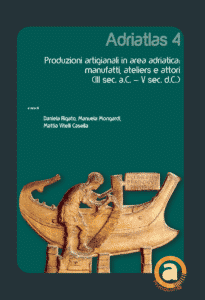UN@ est une plateforme d'édition de livres numériques pour les presses universitaires de Nouvelle-Aquitaine
Auteur : Mariangela Pignataro
Mariangela Pignataro obtained her BA in Sciences of Cultural Heritage (Archaeological Heritage program) and her MA in Archaeology (Classical Archaeology program) from the University of Bari “Aldo Moro” (Italy), specializing in the study of transport amphorae. She then completed the Post-Graduate School of Archaeological Heritage program at the University of Basilicata (Matera, Italy) with a thesis about an indigenous necropolis in Basilicata.
She has participated as a staff member in some national and international archaeological research projects in the Italian regions of Apulia and Basilicata and in Pompeii, serving as trench supervisor, finds supervisor, finds school supervisor, field assistant and assistant trench supervisor. She has also collaborated to the organization of archaeological exhibitions and national congresses.
Her research interests are in pottery and its production, with a focus on Southern Italy matt-painted pottery, transport amphorae and black gloss ware, in storage and management of archaeological finds, in ancient restoration of pottery and in the use of GIS in archaeology. As a pottery specialist, she is currently involved in some landscape, urban, underwater and funerary archaeology projects carried out by the University of Foggia (Italy), the University of Bari “Aldo Moro” (Italy) and Mount Allison University (Canada) in Apulia and Basilicata.
As a contractor, she works in archaeological excavations and surveys, cataloging and preventive archaeology.
References
Battiloro, I., Mogetta, M., Barretta, M., Diffendale, D. P., D’Esposito, L., Harder, M. C., Pardini, G., Pignataro, M., Russo, A. and Varriale, I. (2018): “New investigations at the sanctuary of Venus at Pompeii: interim report on the 2017 season of the Venus Pompeiana Project”, FOLD&R Italy Series, 425, 1-37.
http://www.fastionline.org/docs/FOLDER-it-2018-425.pdf
Roubis, D. e Pignataro, M. (2016 – 2018): “Per un’archeologia del restauro funzionale in antico sui grandi contenitori: esempi da Difesa San Biagio (Basilicata – MT)”, Siris, 16, 133-156.
https://edipuglia.it/siris-16-2016-open-access/ (full journal issue)
Conte, R., Giannico, V., Palmisano, D., e Pignataro, M. (2017): “Il contesto ceramico tardoantico del quartiere produttivo e residenziale di Egnazia (Fasano, Italia)” in: Dixneuf, D. (ed.), LRCW 5. Late Roman coarse wares, cooking wares and amphorae in the Mediterranean, Études Alexandrines 42, CEAlex, Alexandrie, 419-438.
Gramegna, G. T. I., e Pignataro, M. (2016): “Un contesto ceramico da Egnazia (Fasano, Italia): l’area ad est delle terme” in: Biegert, S. (ed.), Rei Cretariae Romanae Fautorum Acta 44, Bonn, 191-201.
https://www.academia.edu/35542659/_Un_contesto_ceramico_da_Egnazia_Fasano_Italia_larea_ad_est_delle_terme_by_G_T_I_Gramegna_and_M_Pignataro
Berloco, V., Conte, R., Foscolo, M., Giannico, V., Palmisano, D., Pignataro, M. e Schiavariello, G. (2014): “Stratigrafia dei ‘butti’: su alcuni contesti ‘chiusi’ da Egnazia (Fasano – Italia)” in: Biegert, S. (ed.), Rei Cretariae Romanae Fautorum Acta 43, Bonn, 203-218.
https://www.academia.edu/7990606/_Stratigrafia_dei_butti_su_alcuni_contesti_chiusi_da_Egnazia_Fasano_Italia_by_V_Berloco_R_Conte_M_Foscolo_V_Giannico_D_Palmisano_M_Pignataro_G_Schiavariello
Pignataro, M. (2012): “Età repubblicana. Le anfore” in: Fioriello, C. S. (ed.): Ceramica romana nella Puglia adriatica, Bari, 394.
Nella Puglia meridionale la facile disponibilità di argille adatte alla modellazione di forme ceramiche è elemento che nel corso dei secoli ha determinato lo sviluppo di un artigianato capace di produzioni destinate agli usi quotidiani ma anche di realizzazioni che si collocano in un ambito di pregio artistico.



